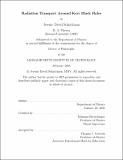Radiation transport around Kerr black holes
Author(s)
Schnittman, Jeremy David
DownloadFull printable version (5.545Mb)
Other Contributors
Massachusetts Institute of Technology. Dept. of Physics.
Advisor
Edmund Bertschinger.
Terms of use
Metadata
Show full item recordAbstract
This Thesis describes the basic framework of a relativistic ray-tracing code for analyzing accretion processes around Kerr black holes. We begin in Chapter 1 with a brief historical summary of the major advances in black hole astrophysics over the past few decades. In Chapter 2 we present a detailed description of the ray-tracing code, which can be used to calculate the transfer function between the plane of the accretion disk and the detector plane, an important tool for modeling relativistically broadened emission lines. Observations from the Rossi X-Ray Timing Explorer have shown the existence of high frequency quasi-periodic oscillations (HFQPOs) in a number of black hole binary systems. In Chapter 3, we employ a simple \hot spot" model to explain the position and amplitude of these HFQPO peaks. The power spectrum of the periodic X-ray light curve consists of multiple peaks located at integral combinations of the black hole coordinate frequencies, with the relative amplitude of each peak determined by the orbital inclination, eccentricity, and hot spot arc length. In Chapter 4, we introduce additional features to the model to explain the broadening of the QPO peaks as well as the damping of higher frequency harmonics in the power spectrum. The complete model is used to fit the power spectra observed in XTE J1550-564, giving confidence limits on each of the model parameters. In Chapter 5 we present a description of the structure of a relativistic alpha-disk around a Kerr black hole. Given the surface temperature of the disk, the observed spectrum is calculated using the transfer function mentioned above. (cont.) The features of this modified thermal spectrum may be used to infer the physical properties of the accretion disk and the central black hole. In Chapter 6 we develop a Monte Carlo code to calculate the detailed propagation of photons from a hot spot emitter scattering through a corona surrounding the black hole. The coronal scattering has two major observable effects: the inverse-Compton process alters the photon spectrum by adding a high energy power-law tail, and the random scattering of each photon effectively damps out the highest frequency modulations in the X-ray light curve.
Description
Thesis (Ph. D.)--Massachusetts Institute of Technology, Dept. of Physics, 2005. This electronic version was submitted by the student author. The certified thesis is available in the Institute Archives and Special Collections. Includes bibliographical references (p. 201-212).
Date issued
2005Department
Massachusetts Institute of Technology. Department of PhysicsPublisher
Massachusetts Institute of Technology
Keywords
Physics.